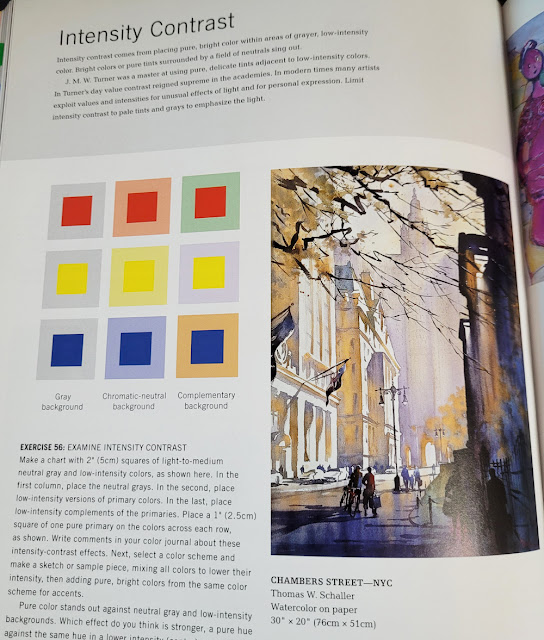 |
| Exploring Color Workshop by Nita Leland (All the Post-its tell me that it's time to buy my own copy!) |
When I first began sketching, using color seemed easy
because I applied it the way I would in a coloring book: Draw the outlines of
the shapes I saw, then color them in with hues that matched “reality” as
closely as possible. But the more I studied and eventually understood values,
the more confusing color became. In fact, I became downright flummoxed and
intimidated by color.
In recent years, I’ve made a conscious effort to learn how to use color in support of values – not just coloring in shapes. I still struggle constantly, but studying concepts like color temperature, especially in Sarah Bixler’s workshop more than a year ago, helped me to understand color and values in a whole different way.
Around the same time, I started experimenting with limited palettes, especially CMY-based primary triads and secondary triads, which again changed my perspective of how colors can be used in a more cohesive, harmonious way. In addition to giving me intriguing mixes to play with, such limited palettes encourage me to be less literal with color (Notice all my purple trees lately? And green faces?).
All of that is lengthy preamble for what must be obvious: I’ve become increasingly fascinated with learning how to use color in dynamic ways. Going through every book in the library on the subject, I’ve found the best of the bunch so far to be Exploring Color Workshop (30th Anniversary Edition) by Nita Leland. A long-time writer for North Light Books, Leland has published numerous titles on the topic of color. Originally published in 1980, Exploring Color Workshop was revised in 2016 with new exercises and lessons. Another update is information and discussion of “modern pigments” – the ones that make CMY triads!
 |
| A demo of using different variations of primary triads to paint the same scene. |
Showing how toned supports and underpainting affect the final hues, temperature contrasts, limited palettes, triads based on both traditional and modern pigments – everything I love is here, plus lots that I didn’t know I loved until I saw it!
 |
| Examples of analogous color scheme |
Going far beyond basic color theory and color wheels, Exploring Color Workshop shows contemporary art works (and references master works that can be easily found online) that use a monochromatic scheme, for example, or a high-key modern palette. Although I understand those words, it’s hard for me to picture a “high-key modern palette” just by looking at a color wheel, but the painting shown on the page makes it instantly clear.
 |
| Example of strong contrasts in color intensity |
The “workshop” part of the book consists of 89 exercises to further understand concepts. The author encourages creating a color journal specifically for the purpose of studying color, storing results and notes from the exercises, and ultimately documenting the development of a personal palette. I experiment with palettes all the time, yet I tend to make the mixes and notes next to sketches or in random sketchbooks, so it’s hard to find them again. (In fact, one reason I post my palettes here on my blog is so that I can refer to them!) As soon as I read this idea, I decided to start keeping a dedicated color journal that would serve much better as a reference tool than my current methods.
 |
| A demo on using an underpainting to unify a color palette |
Although the primary audience is obviously painters, the author addresses artists of all kinds of media, including collage and fiber, so most of the exercises can be done without mixing liquid paints – for example, dry media or magazine cut-outs could be used. I think I could use colored pencils for almost all exercises and still get the concepts.
 |
| A self-portrait demo that begins with darks |
Another significant part of the book are the stepped-out demonstrations by the author, usually in the form of paintings or sketches, to illustrate concepts.
For diehard color geeks, the book also includes reference tables of ASTM pigment names and their color index numbers. More useful to me are charts comparing various characteristics of pigments, such as staining and granulation tendencies.
After my first pass, my library copy was bristling with Post-its on pages that I need to study further. That’s usually a sign that I might as well buy my own copy, which I did.

I remember reading one of her books (possibly this one) many years ago. I think my sister has a copy. Maybe I should take a fresh look at it.
ReplyDeleteShe has written several books on the subject of color -- I'm sure they're all great!
DeleteI thought I had a color workshop book, in fact I kept it next to my desk to work in. Not remembering the images you show, I went to Amazon only to be told that I bought a copy in 2021! Certainly because of your influence. But, where is it??? The black hole wins again...Anne HwH
ReplyDeleteI don't think I influenced you in 2021... I didn't know about this book until this year! Would be fun to go into your black hole and see what else is in there! ;-)
Deletewell, at this point there are several pens, books, paper, sketchbooks and sewing materials in the black hole! so annoying :-<
Delete